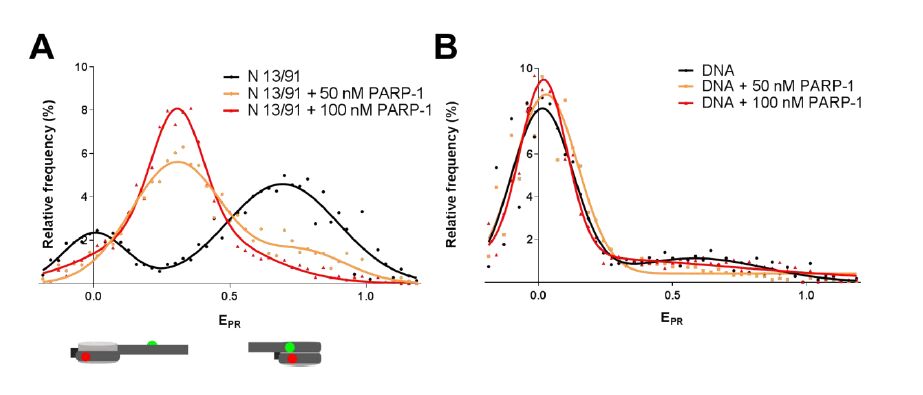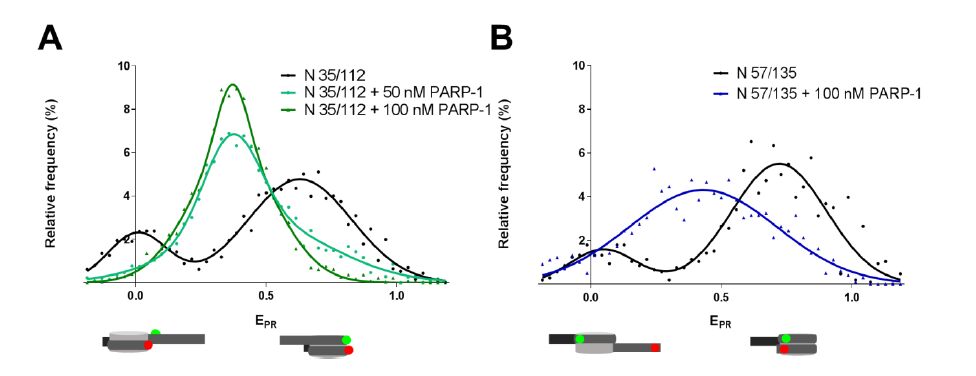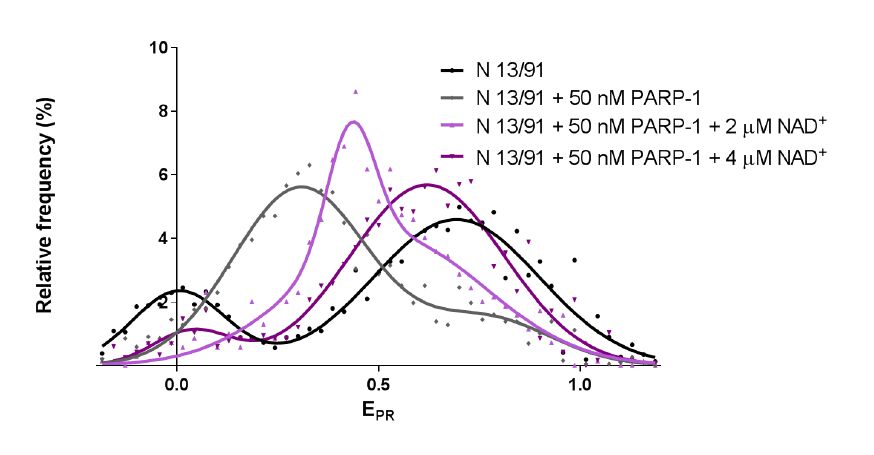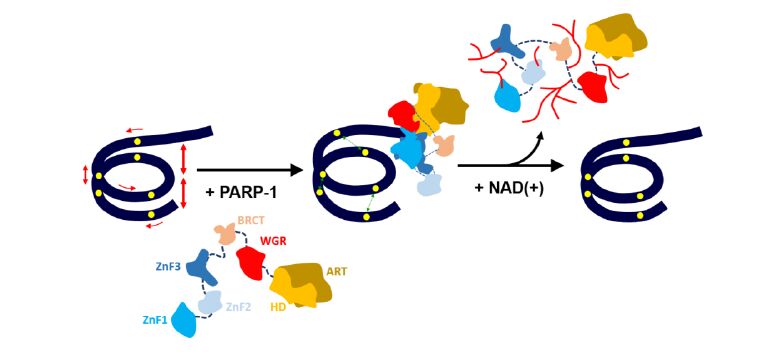DNA accessibility to various protein complexes is essential for various processes in the cell and is affected by nucleosome structure and dynamics. Protein factor PARP-1 (poly(ADP-ribose) polymerase 1) increases the accessibility of DNA in chromatin to repair proteins and transcriptional machinery, but the mechanism and extent of this chromatin reorganization are unknown. Here we report on the effects of PARP-1 on single nucleosomes revealed by spFRET (single-particle Förster Resonance Energy Transfer) microscopy. PARP-1 binding to a double-strand break in the vicinity of a nucleosome results in a significant increase of the distance between the adjacent gyres of nucleosomal DNA. This partial uncoiling of the entire nucleosomal DNA occurs without apparent loss of histones and is reversed after poly(ADP)-ribosylation of PARP-1. Thus PARP-1-nucleosome interactions result in reversible, partial uncoiling of the entire nucleosomal DNA.
1.
Introduction
Derivatives of integer orders are the particular form of fractional order derivatives. When the notation dndtn was presented by Leibniz at the end of 17th century for nth order derivative, L'Hospital asked from him can we take n=12? Leibniz replied "this is an apparent Paradox, from which one day useful consequences will be drawn", and this was the origin of fractional derivatives Riemann-Liouville derivative was originated after the great contributions of mathematicians Fourier and Laplace, and due to this notion of fractional derivative the fractional calculus was developed. After that, researchers showed interest in fractional calculus [4,5,6,7,8,9,13,17,18,19,20,28]. Fractional derivatives are universal operators, which cover different physical phenomena and areas of mathematical modeling such as: control theory [26], dynamical process [24], electro-chemistry [16], image and signal processing [22], mathematical biology [21], etc.
The existence of solutions is the basic subject for the investigation of the fractional differential equations. Numerous mathematicians worked on the existence of solutions for different Boundary Value Problems, Using different fixed point theorems (see [23,29,32]). In [2] Ahmad et al. studied the existence of coupled fractional differential equations involving a p-Laplacian operator by applying fixed point theorems. In [11,12], the authors got theoretical results related to fractional differential equations with p-Laplacian operator (p-LO).
It can be easily observed that obtaining the exact solution of non linear models is a tough and challenging task, to overcome the difficulty, a lot of approximation methods were established. Hyers-Ulam Stability (HUS) can predict the gap between exactness and approximations of the solutions. This notion was initiated (in 1940) by Ulam [25] and further extended by Hyers to abstract spaces, after one year. Recent results shows that different models with different boundary conditions are investigated for HUS [3,15,30,31].
Mohammed et al. [14], explored the existence and uniqueness of solution of a model which involves the Caputo-Katugampola fractional derivative:
where cDβ is a Caputo fractional derivative of order β∈(1,2), cDγ,ρ1, γ∈(0,1) and cDα,ρ, α∈(1,2), ρ>0 are Caputo-Katugampola fractional derivative, ϕp, p>1 is a p-LO.
Hira et al. [27], investigated the existence, uniqueness and HU stability of solutions to nonlinear coupled FDEs:
where 2<αi≤3, 0<β1≤1, ηi, γi>0, ψi∈L[0,T], and cDαi0+ and cDβi0+ are the Caputo derivatives of order αi and βi, i=1,2, respectively. Lp(s)=|s|p−2s is a p-LO, where 1p+1q=1, and Lq denotes inverse of p-Laplacian. Ai:T→R are closed bounded linear operators for any ρ∈T=[0,T], and Φ, Ψ, gk:T×R×R→R, (k=1,2) are continuous functions i=1,2. Ck∈Rn×n, (k=1,2).
In [12], Lu et al. investigated the nonlinear fractional BVP with p-Laplacian operator
where Z∈(2,3], and B∈(1,2]. DZ, DB represents the standard Riemann-Liouville fractional derivatives.
In [2], Ahmad et al. investigated the system:
where cDZ and DB respectively denotes the Caputo and Riemann-Liouville FD of order Z and B, m−1<Z1,Z2,B≤m, m∈{4,5,…}, and 1<δ≤2, K1(⋅), K2(⋅) are linear and bounded operators on R.
Zhang et al. [33], studied the existence of
where Z and B are the orders of Caputo fractional derivatives cDZ and cDB respectively.
Following [33], in this article, we present existence and stability analysis of the model of the form
where 1<m−1<B1;B2<m; 1<n−1<Z1;Z2<n; Z1−B1;Z2−B2>1, Z1;Z2;B1, and B2 be the orders of Caputo fractional derivatives cDZ1, cDZ2, cDB1 and cDB2 respectively, and 0<γ1,γ2≤1. The p-Laplacian operator is represented by ϑp and is defined as ϑp(ϖ)=|ϖ|p−2ϖ,p>1,ϑ−1p=ϑq,1p+1q = 1. S1,S2,S3,S4∈C([0,1],R+), ϝ1, and ϝ2 are appropriate functions. H1,H2,H3,H4∈C([0,1],R+) are perturbation functions.
(C1) 0<∫10H1(ϖ)dϖ<∫10H2(ϖ)dϖ<2∫10H1(ϖ)dϖ<+∞, 0≤S1(α)≤S2(α)≤2S1(α), 0≤∫10S1(ϖ)dϖ, ∫10S2(ϖ)dϖ<1, 0≤S3(α)≤S4(α)≤2S3(α), 0≤∫10S3(ϖ)dϖ, ∫10S4(ϖ)dϖ<1.
The remaining manuscript is as follows: Section 2 contains basic definitions, auxiliary lemmas and related theorems. In Section 3, we present the existence theory for the problem (1.2) and gives some related properties of Green function. In Section 4, we obtain at least three positive solutions of coupled system (1.2) by using the Avery-Peterson fixed point theorem. Section 5 contains HU type stability results, and Section 6 provide an example to authenticate the theoretical result.
2.
Preliminaries
Here, we are presenting an important literature concerning the Caputo fractional derivatives and integral, which gives us help throughout this article, for the details, reader should study [1,10].
Definition 2.1. Let X∈L1([0,T],R+) be a function. Then the Z order fractional integral is defined by
on the condition that the integral on right side exists, where Γ is the Euler Gamma function, defined as
Definition 2.2. Let X:[0,T]→R be a function. Then the Z> order fractional derivative is defined as
on the condition that the integral on the right side exists, and [Z] denote the integer part of a real number Z, where n=1+[Z].
Definition 2.3. Let X:[0,T]→R be a function. Then the Z order sequential fractional derivative is defined as:
where Z=(Z1,Z2,Z3,…,Zm) is any multi-index, and the operator DZ can either be Riemann-Liouville or Caputo or any other kind of integro-differential operator.
Lemma 2.1. For any Z>0, the Caputo FDE cDZX(α)=0 has a solution of the form
where ei∈R,i=¯0,n−1, and n=1+[Z].
Lemma 2.2. For any Z>0, we have
where ei∈R,i=¯0,n−1, and n=1+[Z].
Lemma 2.3. [33] Let ϝ1∈C([0,1],R), and 1<m−1<B1<m. Then
has a solution (unique)
where
Let
From (C1), we know for α∈(0,1),
and
Implies
3.
Existence of solutions
For our results we need an assumption and the lemma.
(C2) δ−1S1=1−2MS1+M′S1≠0, δ−1S2=1+MS2−M′S2≠0 and δS1δS2(2MS2−M′S2)(M′S1−MS1)≠1.
Lemma 3.1. Let (C2) hold, n−1<Z1≤n and h1:J→R are is an appropriate function. The BVP:
has solution(unique) of the form
where
and
Proof. Consider
Using Lemma 2.2, we get
Using boundary conditions of (3.1), we get
and e2=e3=⋯=en−1=0. Putting e's in (3.7) and
where G1(α,ϖ) is given in (3.4), AS1=∫10S1(ϖ)X(ϖ)dϖ and AS2=∫10S2(ϖ)X(ϖ)dϖ.
In view of (3.8), we get
Integrating (3.9) from 0 to 1, we obtain
Implies that
Similarly, we obtain
Implies that
From (3.10) and (3.12), we get
and
Putting (3.12) and (3.13) in (3.8), we get
From (2.3) and (2.4), we can write (3.14) as
□
Lemma 3.2. The coupled BVP (1.2) is equivalent to the following system of integral equations
where G⋅(α,ϖ) and K⋅(α,ϖ) are given by (3.3) and (2.2).
Proof. Using Lemmas 2.3 and 3.1, set ω(α)=ϑp(DZ1X(α)) and h1(α)=ϝ1(α,Dγ1X(α),Dγ2Y(α)), and we have
Similarly, we can set ω(α)=ϑp(DZ2Y(α)) and h2(α)=ϝ2(α,Dγ1X(α),Dγ2Y(α)), we obtain
On the other hand, if (X,Y) satisfy (3.15), we can easily prove that (X,Y) satisfy the pair of boundary value problem (1.2). Hence, the proof is completed. □
Lemma 3.3. We use GZ(α,ϖ)=(GZ1(α,ϖ),GZ2(α,ϖ)) and KB(α,ϖ)=(KB1(α,ϖ),KB2(α,ϖ)) as the Green's functions of the proposed system (1.2) having the following properties:
(I) KB(α,ϖ)≥0 is continuous for all α,ϖ∈[0,1];
(II) KB(α,ϖ)≤KB(s,ϖ) for all α,ϖ∈[0,1];
(III) ∫10KB1(α,ϖ)dϖ=1−αB1Γ(B1+1)≤1Γ(B1+1) for all α,ϖ∈[0,1];
∫10KB2(α,ϖ)dϖ=1−αB2Γ(B2+1)≤1Γ(B2+1) for all α,ϖ∈[0,1];
(IV) GZ(α,ϖ)≥0 is continuous for all α,ϖ∈[0,1];
(V) ψ(α)=(ψ1(α),ψ2(α))≥0 for all α∈[0,1];
Proof. The proofs of (I) and (II) can be seen in [33].
(III) For α∈[0,1], we have
Also,
(IV) Firstly, from (3.4), one get G1(α,ϖ)≥0, α,ϖ∈[0,1], and from (C1), δ>0 and G1(α,ϖ)≥0, we have
Thus G2(α,ϖ) is a increasing on α∈[0,1].
Utilizing (3.5), we get
So that GZ1(α,ϖ)≥0. Similarly GZ2(α,ϖ)≥0. Hence, GZ(α,ϖ)≥0.
(V) From (C1) and (2.5), we know
Thus ψ1(α), is increasing on α∈[0,1].
From (2.5), we have
Similarly ψ1(α)≥0, and hence ψ(α)≥0. □
Lemma 3.4. For κ∈(0,12), let
where ρZ1=2M′S1−M′S21+MS2+M′S1−MS1 and ρZ2=2M′S3−M′S41+MS4+M′S3−MS3.
Proof. First Step. We need to get
For ϖ<α, where ϖ∈[0,1) and α∈[0,κ], we have
which implies that G1(α,ϖ) is decreasing function monotonically with respect to α∈[ϖ,κ], so that
and
Now if ϖ≥α and α∈[0,κ],
which implies that G1(α,ϖ) is a monotone decreasing function with respect to α∈[0,ϖ] and α∈[0,κ], so that
and
Thus, (3.16) is satisfied.
Similarly, we get
Step 2. We prove
From Lemma 3.3, we know that G2(α,ϖ) is increasing for α∈[0,1], in such a way that
By (C1) and (2.7), we have
Obviously, ρZ1>0, and
Thus 0<ρZ1<12 and (3.18) is satisfied.
By the same procedure,
Finally, from (3.16) and (3.18), we can easily show that the following results hold:
and
Similarly, from (3.17) and (3.19), we can also easily show that
and
□
Lemma 3.5. If (C1) is satisfied, then ψ(α) holds the following properties:
(I) ψ1(α)≤ψ1(1)=maxα∈[0,1]ψ1(α) and ψ2(α)≤ψ2(1)=maxα∈[0,1]ψ2(α);
(II) minα∈[0,κ]ψ1(α)≥ρZ1maxα∈[0,1]ψ1(α) and minα∈[0,κ]ψ2(α)≥ρZ2maxα∈[0,1]ψ2(α).
Proof. Using Lemma 3.3 and (2.5), implies ψ1(α) is increasing on α∈[0,1], and thus
and
Setting H2(0)=2H1(0) and H1(1)=0, then (3.20) implies
Also,
Thus,
□
4.
Major findings
Suppose that μ1 and μ2 be nonnegative convex and continuous functionals on Θ, μ3 be nonnegative concave and continuous functional on Θ and μ4 be a nonnegative continuous functional on Θ. For M1,M2,M3,M4>0, let us introduce the convex sets:
and a closed set
Lemma 4.1. Let Θ be a cone in a real Banach space χ. Let μ1 and μ2 be nonnegative continuous convex functionals on Θ, μ3 be nonnegative continuous concave functional on Θ and μ4 be a nonnegative continuous functionals on Θ satisfying μ4(λ(X,Y))≤λμ4(X,Y) for 0≤λ≤1, such that for some positive numbers N and M1,
for all (X,Y)∈¯Θ(μ1,M1). Suppose
is completely continuous and there exist positive numbers M2, M3 and M4 with M4<M3 such that
(C3): {(X,Y)∈Θ(μ1,μ2,μ3; M3,M2,M1):μ3(X,Y)>M3}≠∅ and μ3(X,Y)>M3 for (X,Y)∈Θ(μ1,μ2,μ3; M3,M2,M1);
(C4): μ3(T(X,Y))>M3 for (X,Y)∈Θ(μ1,μ3;M3,M1) with μ2(T(X,Y))>M4;
(C5): (0,0)∉Θ(μ1,μ4;M4,M1) and μ4(T(X,Y))<M4 for (X,Y)∈Θ(μ1,μ4;M4,M1) with μ4(X,Y)=M4.
Then, T has at least three fixed points (X1,Y1),(X2,Y2),(X3,Y3)∈¯Θ(μ1,M1) such that
Let χ={(X,Y)∈C([0,1],R)×C([0,1],R)} be endowed with the norm ‖(X,Y)‖=maxα∈[0,1]|(X,Y)|, then χ is a Banach space.
We define a set Θ⊂χ by
For (X,Y),(˜X,˜Y)∈Θ and ν1,ν2≥0, it is easy to obtain that ν1(X,Y)(α)+ν2(˜X,˜Y)(α)≥0, and
Thus, for (X,Y),(˜X,˜Y)∈Θ and ν1,ν2≥0, ν1(X,Y)(α)+ν2(˜X,˜Y)(α)∈Θ. And if (X,Y)∈Θ, (X,Y)≠0, it can be seen that −(X,Y)∉Θ. Thus, Θ is a cone in χ.
Let T:Θ→χ be an operator, i.e., T=(T1,T2), defined by
Lemma 4.2. If (C1) is true, then T:Θ→Θ is a completely continuous operator.
Proof. For (X,Y)∈Θ, it is easy to know that T is a continuous operator, and T(X,Y)(α)≥0. By (3.15), we have
Similarly, for minα∈[0,κ]T2(X,Y)(α)≥ρZ2maxα∈[0,1]T2(X,Y)(α). So, T(Θ)⊆Θ.
Set Θτ⊂Θ be bounded, i.e., ∃ a constant τ>0 in such a way that ‖(X,Y)‖≤τ, for every (X,Y)∈Θτ. Let M0=maxα∈[0,1],(X,Y)|ϝ1(α,Dγ1X(α),Dγ2Y(α))|>0 and N0=maxα∈[0,1],(X,Y)|ϝ2(α,Dγ1X(α),Dγ2Y(α))|>0. For (X,Y)∈Θτ, from Lemmas 3.3 and 3.4, we have
and
Similarly,
and
So that T(X,Y)≤max{M01,N01}, which implies T(Θτ) is uniformly bounded. Next, we will show that T(Θτ) is equicontinuous. Since GZ(α,ϖ), ψ(α) are continuous on [0,1]×[0,1], it is uniformly continuous on [0,1]×[0,1]. Thus, for any ϵ>0, there exists a constant ς1>0, such that
for α1,α2∈[0,1] with |α1−α2|<ς1. Therefore,
Similarly
Combining (4.4) and (4.6), we obtain
Implies, T(Θτ) is equicontinuous.
Thus Arzelˊa-Ascoli Theorem implies that T is a completely continuous operator.
□
Define the functionals
then μ1 and μ2 are continuous nonnegative convex functionals, μ3 is a continuous nonnegative concave functional, μ4 is a continuous nonnegative functional, and
Thus, (4.1) in Lemma 4.1 is fulfilled.
Let
Theorem 4.1. Let (C1) is true, and ∃ constants M1,M3,M4≥ψ(1) with M4<M3<ρM1minl2l4l1l3 and M2=M3ρ, in such a way that
(C6) ϝ1(α,X,Y)≤ϑp(M1−ψ1(1)l1) and ϝ2(α,X,Y)≤ϑp(M1−ψ2(1)l2), (α,X,Y)∈[0,1]×[0,M1]×[0,M1];
(C7) ϝ1(α,X,Y)>ϑp(M3−ρZ1ψ1(1)ρZ1l3) and ϝ2(α,X,Y)>ϑp(M3−ρZ2ψ2(1)ρZ2l4), (α,X,Y)∈[0,κ]×[M3,M3ρZ1]×[0,M1];
(C8) ϝ1(α,X,Y)<ϑp(M4−ψ1(1)l1) and ϝ2(α,X,Y)<ϑp(M4−ψ2(1)l2), (α,X,Y)∈[0,1]×[0,M4]×[0,M1].
Then, (1.2) has at least three positive solutions (X1,Y1), (X2,Y2), (X3,Y3) satisfying
Proof. Obviously, the fixed points of T are equivalent to the solutions of (1.2). For (X,Y)∈¯Θ(μ1,M1), we get
thus
and then
By (C6), we have
Similarly,
So,
Thus, T:¯Θ(μ1,M1)→¯Θ(μ1,M1).
For (X,Y)=M3ρ, (X,Y)(α)∈Θ(μ1,μ2,μ3;M3,M2,M1), μ3(M3ρ)>M3, we get
For (X,Y)(α)∈Θ(μ1,μ2,μ3;M3,M2,M1), we know that M3≤(X,Y)(α)≤M2=M3ρ for α∈[0,κ].
In view of (C7),
Similarly,
So, μ3(T(X,Y))>M3 for all (X,Y)(α)∈Θ(μ1,μ2,μ3;M3,M2,M1). Hence, (C3) of Lemma 4.1 is fulfilled.
By (4.7), for all (X,Y)∈Θ(μ1,μ3;M3,M1) with μ2(T(X,Y))>M2=M3ρ, one get
Implies (C4) of Lemma 4.1 is true.
As μ4(0,0)=0<M4, thus 0∉Θ(μ1,μ4;M4,M1). If (X,Y)∈Θ(μ1,μ4;M4,M1) with μ4(X,Y)=M4, we deduced μ1(X,Y)≤M1. Thus, maxα∈[0,1](X,Y)(α)=M4 and 0≤(X,Y)(α)≤M1.
Using (C8), we get
Similarly,
So, μ3(T(X,Y))<M3 for all (X,Y)(α)∈Θ(μ1,μ4;M4,M1). Therefore, the condition (C4) of Lemma 4.1 hold.
To sum up, all the conditions of Lemma 4.1 are verified, and it was noticed that (Xi,Yi)(α)≥ψ(0)>0. Hence, the coupled system (1.2) has at least three positive solutions (X1,Y1), (X2,Y2), (X3,Y3) satisfying (4.7) and (4.8). □
5.
Stability results
Definition 5.1. The system (1.2) is HU stable if there exist πZ1,Z2=max{πZ1,πZ2}>0 in such a way that, for ε=max{εZ1,εZ2}>0 and for any (X,Y)∈χ satisfying
∃ (ˆX,ˆY)∈χ satisfying (1.2) such that
Definition 5.2. The coupled implicit FDEs (1.2) is GHU stable if there exist Φ∈C(R+,R+) with Φ(0)=0 such that, for any solution (X,Y)∈χ of inequality (5.1), there exists a solution (ˆX,ˆY)∈χ of (1.2) fulfilling
Let ΨZ1,Z2=max{ΨZ1,ΨZ2}∈C([0,1],R), and πΨZ1,ΨZ2=max{πΨZ1,πΨZ2}>0.
Definition 5.3. The coupled system of implicit FDEs (1.2) is said to be HUR stable with respect to ΨZ1,Z2 if there exists constants πΨZ1,ΨZ2 such that, for some ε>0 and for any solution (X,Y)∈χ of the inequality
there exists (ˆX,ˆY)∈χ satisfying (1.2) in such a way that
Definition 5.4. The system (1.2) is said to be HUR stable with respect to ΨZ1,Z2 if there exists constants πΨZ1,ΨZ2 such that, for any approximate solution (X,Y)∈χ of inequality (5.2), there exists a solution (ˆX,ˆY)∈χ of (1.2) fulfilling
Remark 5.1. We say that (X,Y)∈χ is a solution of the system of inequalities (5.1) if there exist functions Λf, Λg∈C([0,1],R) depending upon X,Y, respectively, such that
(I)
(II)
Lemma 5.1. Under the assumptions given in Remark 5.1, the solution (X,Y)∈χ of coupled system
satisfies the system of inequalities
Proof. In light of Lemma 3.2, a solution of the coupled system (5.1) is
Using (4.2) in (5.6), we have
Similarly, using (4.3) in (5.6), we get
□
For the next result, we suppose the following condition.
(C9) Let N1,N2,S1,S2∈C([0,1],R), and there exists L1,L2,L3,L4>0 such that
Theorem 5.1. Suppose the condition (C9) and Lemma 5.1 satisfies, then (1.2) is HU stable, if υ1υ4−υ2υ3=υ4−υ2>0, where
Proof. Consider (X,Y)∈χ to be any solution of (5.5), and (ˆX,ˆY)∈χ is a solution of the coupled system (1.2), then we take
implies that
Similarly, we have
From (5.7) and (5.8), we get
implies
From system (5.9), we have
which implies that
If max{ϑq(εZ1),ϑq(εZ2)}=ϑq(εZ) and υ1υ4−υ2N01−ψ2(1)ϑq(N0)+υ2υ4−υ2N01−ψ2(1)ϑq(N0)+υ3υ4−υ2M01−ψ1(1)ϑq(M0)+υ4υ4−υ2M01−ψ1(1)ϑq(M0)=υZ1,Z2, then
Hence, system (1.2) is HU stable. Also, if
with Φ(0)=0, then the solution of system (1.2) is GHU stable. □
Theorem 5.2. Suppose the conditions (C9) and Lemma 5.1 holds, then (1.2) is GHU stable, if υ1υ4−υ2υ3=υ4−υ2>0, where υ1, υ2, υ3 and υ4 is defined in Theorem 5.1.
Proof. By applying steps of Theorem 5.1, we can easily show that system (1.2) is GHU stable, by using Definition 5.4. □
For the next theorem, we assume that
(C10) ∃ non-decreasing functions ˉwZ,ˉwB∈C([0,1],R+) in such a way that
and
where LZ,LB>0.
Theorem 5.3. Suppose the conditions (C9), (C10) and Lemma 5.1 satisfies, then system (1.2) is HUR stable if υ1υ4−υ2υ3=υ4−υ2>0.
Proof. By applying steps of Theorem 5.1, we can easily show that system (1.2) is HUR stable, by using Definition 5.3. □
Theorem 5.4. Suppose the conditions (C9), (C10) and Lemma 5.1 holds, then system (1.2) is GHUR stable if υ1υ4−υ2υ3=υ4−υ2>0.
Proof. By applying steps of Theorem 5.1, we can easily show that system (1.2) is GHUR stable, by using Definition 5.4. □
6.
Example
In this section, we demonstrate an example to illustrate the main results.
Example 6.1. Consider the following system of implicit FDEs:
Choosing M1=25000, M3=65, M4=3 and κ=13. Reminding ψ1, ψ2 from (2.5), (2.6) and ρZ1 and ρZ2 from Lemma 3.4, we get
In (6.1), we see that
which satisfies the following conditions:
(C6) supϝ1(α,X,Y)≈246.534≤minϑp(M1−ψ1(1)l1)≈291.732,
supϝ2(α,X,Y)≈241.492≤minϑp(M1−ψ2(1)l2)≈284.618, (α,X,Y)∈[0,1]×[0,25000]×[0,25000];
(C7) infϝ1(α,X,Y)≈240.631>ϑp(M3−ρZ1ψ1(1)ρZ1l3)≈201.981 (α,X,Y)∈[0,13]×[65,M3ρZ1]×[0,25000];
infϝ2(α,X,Y)≈271>ϑp(M3−ρZ2ψ2(1)ρZ2l4)≈201.843, (α,X,Y)∈[0,13]×[65,M3ρZ2]×[0,25000];
(C8) supϝ2(α,X,Y)≈198.938<ϑp(M4−ψ1(1)l1)≈243.861,
supϝ2(α,X,Y)≈183.861<ϑp(M4−ψ2(1)l2)≈202.991, (α,X,Y)∈[0,1]×[0,3]×[0,25000].
Then, all assumptions of Theorem 4.1 are satisfied. Thus, BVP (6.1) has at least three positive solutions (X1,Y1), (X2,Y2), (X3,Y3) satisfying
For HUS, we found L1=L2=1150, L3=L4=1160, υ1≈0.02961, υ2≈0.9721, υ3≈0.03291 and υ4≈0.9948. Hence, by Theorem 5.1, we have υ4−υ2≈0.9948−0.0227>0.
7.
Conclusions
In this paper, we considered an implicit coupled BVP of p-Laplacian FDEs (1.2), which involved disturbing functions. The relating fractional order derivative is taken in Caputo sense. By using the Avery-Peterson fixed point theorem for the proposed problem, we found at least three solutions, under sufficient conditions. In addition, we presented four types of Ulam's stability, i.e., Hyers-Ulam stability, generalized Hyers-Ulam stability, Hyers-Ulam-Rassias stability and generalized Hyers-Ulam-Rassias stability, for the coupled implicit fractional p-Laplacian system, and an example is provided to authenticate the theoretical results.
Acknowledgments
This research is supported by the scientific research project of Anhui Provincial Department of Education (KJ2021A1155; KJ2020A0780).
Conflict of interest
The authors declare no conflict of interest.


















 DownLoad:
DownLoad: